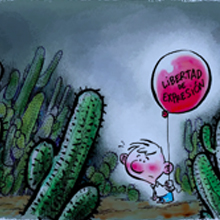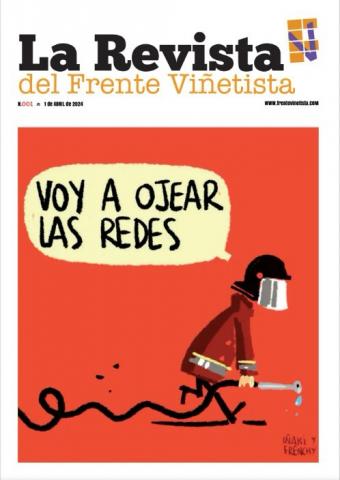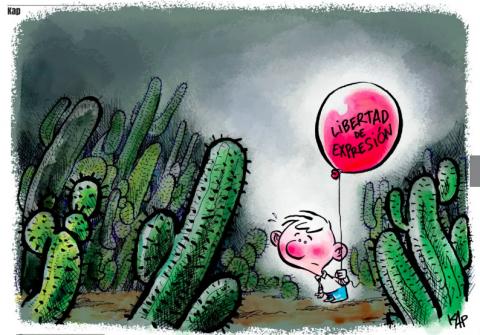
Los humoristas gráficos españoles están de enhorabuena con la aparición del número 1 de la Revista Frente Viñetista, que llena un vacio importante: promover el humor gráfico y dignificar la profesión, y que permitirá acceder y adquirir obras de reconocidos artistas, descubrir nuevos valores y tener de primera mano información de lo que ocurre en el mundo visual como conocer la exposiciones que se realicen, y participar o contratar talleres de iniciación al dibujo y la caricatura.
Hace poco más de cinco años, Estrella Caso, experta en marketing y redes sociales y apasionada por el humor gráfico, junto con amigos suyos dibujantes, como Eneko, Kap y Anne Derenne, creó la asociación de profesionales del humor gráfico, Frente Viñetista, con la idea de difundir las obras de autores de la actualidad y exponerlas a través de una plataforma adecuada, a la vez que poner su actividad al servicio de la defensa de los derechos humanos, en colaboración con Amnistía Internacional. Así comenzó a funcionar la web www.frentevinetista.com.
Ahora, surge, como una nueva herramienta de comunicación, cohesión y proyección de esta entidad, la Revista Frente Viñetista, que está presidida por Manuel Álvarez Junco y tiene como Coordinador Editorial a Jaume Capdevila “Kap”.
Precisamente, conversamos en exclusiva para este Boletín de Humor Sapiens, con Junco sobre los objetivos de esta plataforma, y otros temas de interés.
“Los objetivos y funciones del Frente Viñetista –explica Junco- son la difusión y visualización en general del humor gráfico español, la información del momento de este sector en nuestro país y la posibilidad de que particulares o instituciones puedan contactar con artistas y adquirir sus obras. El hecho de que las personas que se dedican al humor gráfico estén normalmente relacionándose en solitario con los canales de conocimiento y distribución de las obras, precisaba de un lugar que cumpliera las funciones de club de encuentro entre los propios profesionales y los distribuidores y beneficiarios de su obra. Como la labor del humorista es siempre la diversión pero a la vez el cuestionamiento y mejora de la sociedad, suponía también una plataforma adecuada para la necesaria difusión de los derechos humanos. Eso llevó a una simbiosis natural con ONGs como Amnistía Internacional y a la oferta de talleres a instituciones culturales y educativas con viñetistas reconocidos en toda España”.
Leo que también permitirá a los lectores adquirir obras de reconocidos artistas...
“Efectivamente, tenemos una tienda donde se dispone de obras variadas, clásicas y actuales, de artistas reconocidos y otros por descubrir, tanto originales como ediciones impresas y firmadas de piezas de gran calidad. Y un sitio para que instituciones públicas y privadas así como buenos aficionados accedan a la actividad de los autores de la viñeta”.
¿Cómo cataloga el momento actual del humor gráfico en España?
“Confuso y cambiante, tanto para los artistas como para los distribuidores y los aficionados. La llegada de las herramientas y el potencial de las nuevas tecnologías, las redes con sus impresionantes métodos de difusión y rápido feedback, así como la propia Inteligencia Artificial, ha cambiado el panorama totalmente. Las crisis, que antes también eran constantes y graves, se han acelerado ante unos medios y maquinaria que regalan un acceso inmediato y global a la información gráfica. Esto es buenísimo en determinados aspectos, porque siempre hemos deseado todos algo más libre, algo más rápido y algo menos local, pero esto es para muchos algo brutalmente abierto, radicalmente instantáneo y prácticamente universal, aparte de que la remuneración es muchísimo más complicada”.
“Este campo lleno de horizontes desconocidos para España -y para el mundo- ha supuesto hacer emerger propuestas y posibilidades (y miserias) que antes no se podían imaginar. Y la Inteligencia Artificial, un instrumento en principio lleno de posibilidades, también enseña su patita de lobo y amenaza la esperanza de trabajo”.
¿Le da la prensa española el espacio que se merece al humor gráfico?
“Creo que la prensa española también está desconcertada y tienen su propio problema estando en medio del río y pensando si deben cambiar de caballo. De momento los medios más clásicos han conservado las figuras reconocidas y han realizado movimientos como ir incorporado a algunas mujeres humoristas, lo que es un buen síntoma, pero aún están dando palos de ciego. No comprenden del todo que una viñeta (que, por cierto, pueden ya ser animadas sin problema) es un inmejorable e instantáneo resumen visual de una noticia, o sea, una joya irresistible, si es buena, para los nuevos sistemas de difusión”.
¿Cómo enfrentar la política de "cancelación" y censura que sufre el humor gráfico? ¿Cuál es el papel de Frente Viñetista?
“Aquí voy a responder de un modo más personal porque Frente Viñetista agrupa a artistas de muy diferentes opiniones, como debe ser. Pienso yo que la cancelación y la censura siempre siempre siempre han existido, pero ahora hay más libertad y, claro, extraña tanta cancelación y tanta censura. El humor en todos los tiempos ha sido y es contexto y oportunidad, en toda época ha sido concreto y dirigido al momento y ocasión. Eso quiere decir que sufre los avatares y paranoias de su actualidad y justamente el ingenio debe solventarlas. En cualquier caso Frente Viñetista es una plataforma para plantear este tipo de problemas, comentarlos, debatirlos y… ofrecer opiniones y soluciones Como he dicho antes, lo que tenemos muy claro como grupo es una defensa radical de los derechos humanos”.
¿Cada qué tiempo saldrá la revista?
“Acabamos de sacar el número uno y, por cierto, ha quedado fantástico gracias al trabajo conceptual y editorial de Kap. Como soñadores tenemos la idea inicial de sacarla cada tres meses, pero además de soñadores somos realistas y adultos, así que la respuesta adecuada es: “Haciendo el camino, que esperamos sea largo y fructífero, iremos hablando”.
Los lectores de Humor Sapiens pueden disfrutar del numero 1 de la Revista Frente Viñetista en este link:
https://frentevinetista.com/revista-del-frente-vinetista-numero-1/
Para hacerse socio de Frente Viñetista es sencillo, basta con enviar un correo electrónico a contacto@frentevinetista.com, y recibirá una ficha para rellenar y listo. Hay una cuota única anual, de 40 euros (que se recupera si uno vende uno o dos dibujos en la tienda de viñetas, o participa en un taller...). También pueden asociarse personas que no sean dibujantes, pero que les interese, por lo que sea, el mundo del humor gráfico.
Manuel A. Junco (Zamora 1948) es artista gráfico y profesor emérito de Bellas Artes, de la Complu de Madrid. Ha publicado hace mucho tiempo obra gráfica de humor en Triunfo, El País, Interviú y en Saturday Review de NYC. Últimamente publica en LinkedIn, Instagram y Newsweek México. Aydin Dogan Success Award en Estambul 2005. Notario del Humor Feco Spain en 2020. Presente en World Press Cartoon en 2021 y 2022. Miembro de la directiva del Instituto Quevedo del Humor, de Alcalá. Jurado del Premio Nacional de Diseño 2011. Exposiciones individuales en Italia, EEUU, China, Italia, Colombia, México, Kuwait y España.
Tiene varios libros teóricos publicados. Los más interesantes para viñetistas son “El Espejo y el Martillo”, “El humor gráfico (y su mecanismo transgresor)” y el último: “Imágenes cómicas y festivas de la Grecia clásica”.

Revista del Frente Viñetista

Caricatura de Kap

Manuel Álvarez Junco
Visual humor: New digital magazine of graphic humor "Frente Viñetista"
By Francisco Puñal
Spanish graphic humorists are in luck with the appearance of number 1 of the Frente Viñetista Magazine, which fills an important gap: promoting graphic humor and dignifying the profession, and which will allow access and acquisition of works by renowned artists, discovering new values and having first-hand information about what is happening in the visual world, such as learning about the exhibitions that take place, and participating in or hiring introductory workshops in drawing and caricature.
A little over five years ago, Estrella Caso, an expert in marketing and social networks and passionate about graphic humor, together with her cartoonist friends, such as Eneko, Kap and Anne Derenne, created the association of graphic humor professionals, Frente Viñetista, with the idea of disseminating the works of current authors and exposing them through an appropriate platform, while putting their activity at the service of the defense of human rights, in collaboration with Amnesty International. This is how the website www.frentevinetista.com began to work
Now, the Frente Viñetista Magazine emerges, as a new tool for communication, cohesion and projection of this entity, which is chaired by Manuel Álvarez Junco and has Jaume Capdevila “Kap” as Editorial Coordinator.
Precisely, we spoke exclusively for this Humor Sapiens Newsletter, with Junco about the objectives of this platform, and other topics of interest.
“The objectives and functions of the Viñetist Front – explains Junco – are the general dissemination and visualization of Spanish graphic humor, current information on this sector in our country and the possibility that individuals or institutions can contact artists and acquire their works. . The fact that people who are dedicated to graphic humor are normally interacting alone with the channels of knowledge and distribution of the works, required a place that would fulfill the functions of a meeting club between the professionals themselves and the distributors and beneficiaries of the works. his work. Since the comedian's work is always fun but at the same time questioning and improving society, it also provided an appropriate platform for the necessary dissemination of human rights. This led to a natural symbiosis with NGOs such as Amnesty International and the offering of workshops to cultural and educational institutions with recognized cartoonists throughout Spain.”
I read that it will also allow readers to acquire works by renowned artists...
“Indeed, we have a store where we have a variety of works, classic and current, by recognized artists and others to be discovered, both originals and printed and signed editions of high quality pieces. And a place for public and private institutions as well as good fans to access the activity of the authors of the cartoon.”
How do you catalog the current moment of graphic humor in Spain?
“Confusing and changing, for artists, distributors and fans alike. The arrival of the tools and potential of new technologies, networks with their impressive dissemination methods and rapid feedback, as well as Artificial Intelligence itself, has completely changed the landscape. Crises, which were also constant and serious before, have accelerated in the face of media and machinery that provide immediate and global access to graphic information. This is great in certain aspects, because we have all always wanted something freer, something faster and something less local, but for many this is something brutally open, radically instantaneous and practically universal, apart from the fact that the remuneration is much more complicated.
“This field full of unknown horizons for Spain - and for the world - has meant bringing to the surface proposals and possibilities (and miseries) that could not be imagined before. And Artificial Intelligence, an instrument in principle full of possibilities, also shows its wolf paw and threatens the hope of work.”
Does the Spanish press give graphic humor the space it deserves?
“I think the Spanish press is also baffled and they have their own problem being in the middle of the river and wondering if they should change horses. For now, the most classic media have preserved the recognized figures and have made moves such as incorporating some female comedians, which is a good sign, but they are still going blind. They do not fully understand that a cartoon (which, by the way, can already be animated without problem) is an unbeatable and instantaneous visual summary of a news story, that is, an irresistible gem, if it is good, for the new dissemination systems."
How to confront the policy of "cancellation" and censorship that graphic humor suffers? What is the role of Frente Viñetista?
“Here I am going to respond in a more personal way because Frente Viñetista brings together artists with very different opinions, as it should be. I think that cancellation and censorship have always always existed, but now there is more freedom and, of course, so much cancellation and censorship is strange. Humor at all times has been and is context and opportunity, at all times it has been concrete and directed to the moment and occasion. That means that it suffers from the vicissitudes and paranoia of its current situation and precisely ingenuity must solve them. In any case, Frente Viñetista is a platform to raise these types of problems, comment on them, debate them and... offer opinions and solutions. As I have said before, what we are very clear about as a group is a radical defense of human rights.
How often will the magazine come out?
“We just released number one and, by the way, it turned out fantastic thanks to Kap's conceptual and editorial work. As dreamers we have the initial idea of taking it out every three months, but in addition to being dreamers we are realists and adults, so the appropriate response is: “By following the path, which we hope will be long and fruitful, we will talk.”
Humor Sapiens readers can enjoy issue 1 of Frente Viñetista Magazine at this link:
https://frentevinetista.com/revista-del-frente-vinetista-numero-1/
To become a member of Frente Viñetista is simple, just send an email to contacto@frentevinetista.com, and you will receive a form to fill out and that's it. There is a single annual fee of 40 euros (which is recovered if one sells one or two drawings in the cartoon store, or participates in a workshop...). People who are not cartoonists, but who are interested, for whatever reason, in the world of graphic humor can also join.
Manuel A. Junco (Zamora 1948) is a graphic artist and emeritus professor of Fine Arts, at the Complu of Madrid. He has long published humorous graphic works in Triunfo, El País, Interviú and in NYC's Saturday Review. Lately he publishes on LinkedIn, Instagram and Newsweek Mexico. Aydin Dogan Success Award in Istanbul 2005. Notario del Humor Feco Spain in 2020. Present in World Press Cartoon in 2021 and 2022. Member of the board of directors of the Quevedo Institute of Humor, Alcalá. Jury of the National Design Award 2011. Individual exhibitions in Italy, USA, China, Italy, Colombia, Mexico, Kuwait and Spain.
He has several theoretical books published. The most interesting for cartoonists are “The Mirror and the Hammer”, “Graphic humor (and its transgressive mechanism)” and the last: “Comic and festive images of classical Greece”.
(This text has been translated into English by Google Translate)
